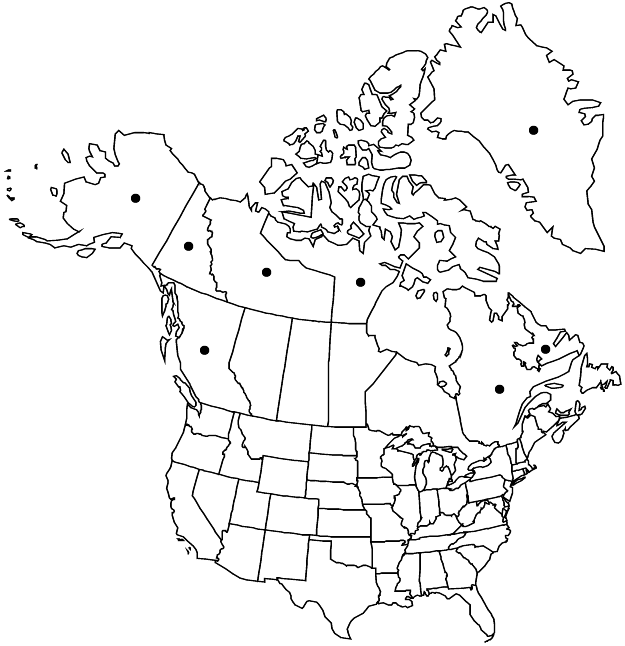Difference between revisions of "Micranthes tenuis"
in N. L. Britton et al., N. Amer. Fl. 22: 136. 1905,.
FNA>Volume Importer |
FNA>Volume Importer |
||
| Line 28: | Line 28: | ||
|elevation=0-1500 m | |elevation=0-1500 m | ||
|distribution=Greenland;B.C.;Nfld. and Labr. (Labr.);N.W.T.;Nunavut;Que.;Yukon;Alaska;Europe;Asia (Siberia). | |distribution=Greenland;B.C.;Nfld. and Labr. (Labr.);N.W.T.;Nunavut;Que.;Yukon;Alaska;Europe;Asia (Siberia). | ||
| − | |discussion=<p>Micranthes tenuis is morphologically distinguished from M. nivalis only with great difficulty. D. A. Webb and R. J. Gornall (1989) claimed that chromosome number is one of the chief reasons for continuing to recognize the species and, indeed, their enumeration of morphologic differences is not entirely convincing. Occasionally, both species appear to occur in the same populations. The generally smaller size, tendency to glabrousness, fewer number of flowers, and petal color variations reasonably distinguish M. tenuis. Depauperate specimens of M. nivalis are particularly difficult to separate from M. tenuis except for their very consistent hairiness and white petals. Due to the morphologic confusion, exact distributions are difficult to assess and chromosome number reports may be doubtful (D. L. Krause and K. I. Beamish 1973). A thorough systematic study is needed.</p> | + | |discussion=<p><i>Micranthes tenuis</i> is morphologically distinguished from <i>M. nivalis</i> only with great difficulty. D. A. Webb and R. J. Gornall (1989) claimed that chromosome number is one of the chief reasons for continuing to recognize the species and, indeed, their enumeration of morphologic differences is not entirely convincing. Occasionally, both species appear to occur in the same populations. The generally smaller size, tendency to glabrousness, fewer number of flowers, and petal color variations reasonably distinguish <i>M. tenuis</i>. Depauperate specimens of <i>M. nivalis</i> are particularly difficult to separate from <i>M. tenuis</i> except for their very consistent hairiness and white petals. Due to the morphologic confusion, exact distributions are difficult to assess and chromosome number reports may be doubtful (D. L. Krause and K. I. Beamish 1973). A thorough systematic study is needed.</p> |
|tables= | |tables= | ||
|references= | |references= | ||
| Line 52: | Line 52: | ||
|publication year= | |publication year= | ||
|special status= | |special status= | ||
| − | |source xml=https://jpend@bitbucket.org/aafc-mbb/fna-data-curation.git/src/ | + | |source xml=https://jpend@bitbucket.org/aafc-mbb/fna-data-curation.git/src/8f726806613d60c220dc4493de13607dd3150896/coarse_grained_fna_xml/V8/V8_125.xml |
|genus=Micranthes | |genus=Micranthes | ||
|species=Micranthes tenuis | |species=Micranthes tenuis | ||
Revision as of 18:04, 18 September 2019
Plants tufted, with bulbils on caudices. Leaves basal; petiole broad, flattened, 0.2–1 cm; blade ± obovate to ± obtrullate, 0.5–1.5 cm, ± coriaceous, base ± attenuate to ± cuneate, margins serrate to dentate on distal 1/3–2/3, sometimes ciliate, surfaces glabrous or glabrate abaxially (rarely sparsely reddish brown-hairy). Inflorescences usually 2–10-flowered, ± capitate cymes, sometimes solitary flowers, (1–)2–7(–11) cm, hairy or glabrous proximally, glabrate or ± purple-tipped stipitate-glandular distally. (Pedicels proximal ± elongate.) Flowers: sepals erect, ovate to deltate; petals white with purple margins, usually pink or purple tinged, not spotted, obovate to oblong, clawed, 2–3 mm, usually slightly longer than sepals; filaments linear, flattened; pistils connate to 1/2 their lengths; ovary 1/2 inferior, appearing more superior in fruit. Capsules reddish to purplish, folliclelike. 2n = 20.
Phenology: Flowering summer.
Habitat: Open, mossy tundra, rocky ridges, shady ledges
Elevation: 0-1500 m
Distribution

Greenland, B.C., Nfld. and Labr. (Labr.), N.W.T., Nunavut, Que., Yukon, Alaska, Europe, Asia (Siberia).
Discussion
Micranthes tenuis is morphologically distinguished from M. nivalis only with great difficulty. D. A. Webb and R. J. Gornall (1989) claimed that chromosome number is one of the chief reasons for continuing to recognize the species and, indeed, their enumeration of morphologic differences is not entirely convincing. Occasionally, both species appear to occur in the same populations. The generally smaller size, tendency to glabrousness, fewer number of flowers, and petal color variations reasonably distinguish M. tenuis. Depauperate specimens of M. nivalis are particularly difficult to separate from M. tenuis except for their very consistent hairiness and white petals. Due to the morphologic confusion, exact distributions are difficult to assess and chromosome number reports may be doubtful (D. L. Krause and K. I. Beamish 1973). A thorough systematic study is needed.
Selected References
None.